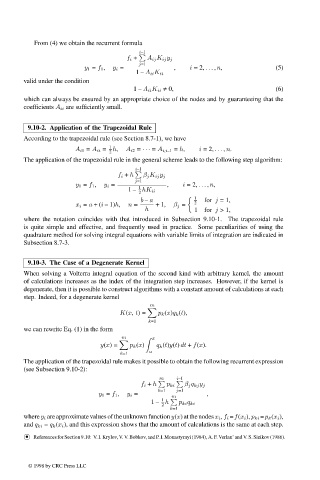Page 506 - Handbook Of Integral Equations
P. 506
From (4) we obtain the recurrent formula
i–1
f i + A ij K ij y j
j=1
y 1 = f 1 , y i = , i =2, ... , n, (5)
1 – A ii K ii
valid under the condition
1 – A ii K ii ≠ 0, (6)
which can always be ensured by an appropriate choice of the nodes and by guaranteeing that the
coefficients A ii are sufficiently small.
9.10-2. Application of the Trapezoidal Rule
According to the trapezoidal rule (see Section 8.7-1), we have
1
A i1 = A ii = h, A i2 = ··· = A i,i–1 = h, i =2, ... , n.
2
The application of the trapezoidal rule in the general scheme leads to the following step algorithm:
i–1
f i + h β j K ij y j
j=1
y 1 = f 1 , y i = , i =2, ... , n,
1
1 – hK ii
2
b – a 1 for j =1,
x i = a +(i – 1)h, n = +1, β j = 2
h 1 for j >1,
where the notation coincides with that introduced in Subsection 9.10-1. The trapezoidal rule
is quite simple and effective, and frequently used in practice. Some peculiarities of using the
quadrature method for solving integral equations with variable limits of integration are indicated in
Subsection 8.7-3.
9.10-3. The Case of a Degenerate Kernel
When solving a Volterra integral equation of the second kind with arbitrary kernel, the amount
of calculations increases as the index of the integration step increases. However, if the kernel is
degenerate, then it is possible to construct algorithms with a constant amount of calculations at each
step. Indeed, for a degenerate kernel
m
K(x, t)= p k (x)q k (t),
k=1
we can rewrite Eq. (1) in the form
m x
y(x)= p k (x) q k (t)y(t) dt + f(x).
a
k=1
The application of the trapezoidal rule makes it possible to obtain the following recurrent expression
(see Subsection 9.10-2):
i–1
m
f i + h p ki β j q kj y j
k=1 j=1
y 1 = f 1 , y i = ,
1
1 – h m p ki q ki
2
k=1
where y i are approximate values of the unknown function y(x) at the nodes x i , f i =f(x i ), p ki =p k (x i ),
and q ki = q k (x i ), and this expression shows that the amount of calculations is the same at each step.
•
References for Section 9.10: V. I. Krylov, V. V. Bobkov, and P. I. Monastyrnyi (1984), A. F. Verlan’ and V. S. Sizikov (1986).
© 1998 by CRC Press LLC
© 1998 by CRC Press LLC
Page 488

